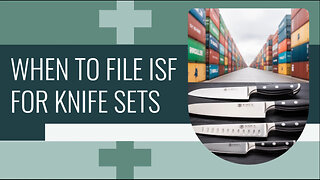Premium Only Content

Mastering the ISF Process: Essential Strategies for Risk Mitigation
License To Import // 323-578-6432 // file@licensetoimport.com // www.licensetoimport.com
In today's video, we discussed strategies for minimizing risks associated with the Importer Security Filing (ISF) process. The ISF requires importers to provide specific information about their shipments to US Customs and Border Protection (CBP) before they arrive in the country. Conducting thorough due diligence, partnering with a knowledgeable customs broker, implementing robust internal compliance procedures, utilizing technology solutions, maintaining ongoing communication, and conducting regular audits are all effective strategies for minimizing risks. By following these strategies, importers can ensure compliance with ISF requirements, avoid penalties, and ensure a smooth customs clearance process.
#usimportbond
#isfcustomsbroker
#uscustomsclearing
#isfentry
Video Disclaimer Here: This video is solely for education and is not endorsed by any US government agency.
00:36 - Importer Security Filing (ISF), also known as the 10+2 rule, requires importers to provide specific information to US Customs and Border Protection before shipments arrive in the country.
00:46 - Strategies for minimizing risks associated with ISF include conducting thorough due diligence to verify information accuracy, partnering with knowledgeable customs brokers, establishing robust internal compliance procedures, and leveraging technology solutions for automation and validation.
2:59 - Maintaining ongoing communication with customs brokers, carriers, and suppliers is crucial to address any issues or changes during the shipment process.
2:35 - Regular audits and compliance reviews are essential for importers to identify and rectify any potential gaps in ISF filings before they result in penalties or delays.
-
 1:39
1:39
License To Import
1 month agoWhen To File ISF For Knife Sets
9 -
 LIVE
LIVE
LumpyPotatoX2
2 hours agoBecome a HellDiver Today - #RumbleGaming
115 watching -
 LIVE
LIVE
Midnight In The Mountains
4 hours agoGaming w/ PER·SE·VER·ANCE | Sassy Saturday Fortnite | with the Midnights!
65 watching -
 LIVE
LIVE
shyboyking
2 hours agoThe Bots Of The Bots !!!😎
84 watching -
 24:06
24:06
True Crime | Unsolved Cases | Mysterious Stories
5 days ago $0.16 earnedShe Traveled Alone… and Never Came Back – 5 Mysterious Unsolved Cases (Part 6)
13.1K5 -
 27:23
27:23
Clickbait Wasteland
16 hours ago $0.04 earnedAsking New Yorkers Who They Support For Mayor: Staten Island
19.5K8 -
 16:58
16:58
World2Briggs
1 day ago $0.03 earnedThe California Rant: Point Blank With No Fluff or BS. California Gold?
12.4K2 -
 17:49
17:49
Chris Harden
1 day ago $0.01 earnedThe Glass Capital That Shattered | The Decline of Streator, Illinois
9.17K1 -
 51:15
51:15
JohnXSantos
3 days ago $0.01 earnedClothing Brand Manufacturers + Winners
5.78K1 -
 10:06
10:06
Cyclops Videos Joe W Rhea
12 days agoHybrid Super 22 Rifle
7K1